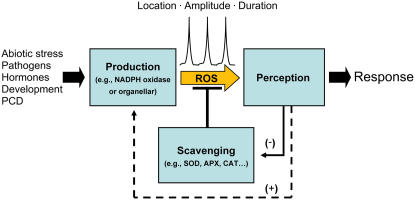Reactive oxygen species (ROS) were initially recognized as toxic by-products of aerobic metabolism, removed by means of antioxidants and antioxidative enzymes. In recent years, it has become apparent that ROS play an important signaling role in plants controlling processes such as growth, development, response to biotic and abiotic environmental stimuli, and programmed cell death. It is the evolution of highly efficient scavenging mechanisms that most likely enabled plant cells to overcome ROS toxicity and led to the use of several of these ephemeral reactive molecules as signal transducers. The recent identification of ROS-generating enzymes, such as the plant homolog of respiratory-burst NADPH oxidases, has led to the demonstration that plant cells, like mammalian cells, can initiate and most likely amplify ROS production for the purpose of signaling. Localized ROS production in organelles such as plastids, mitochondria, and peroxisomes may also initiate signaling cascades. A simple view of ROS signaling in plants is shown in the model in Figure 1.
Figure 1.
ROS form in plant cells as a consequence of myriad stimuli ranging from abiotic and biotic stress, production of hormonal regulators, as well as cell processes such as polar growth and programmed cell death (PCD). These reactive molecules are generated at a number of cellular sites, including mitochondria, chloroplasts, peroxisomes, and at the extracellular side of the plasma membrane. ROS trigger signal transduction events, such as mitogen-activated protein kinase cascades, eliciting specific cellular responses. The influence of these molecules on cellular processes is mediated by both the perpetuation of their production and their amelioration by scavenging enzymes such as superoxide dismutase (SOD), ascorbate peroxidase (APX), and catalase (CAT). The location, amplitude, and duration of production of these molecules determine the specificity of the rapid responses they direct.
The main principle depicted here is that ROS-mediated signaling is controlled by a delicate balance between production and scavenging. The localized and temporal production of ROS is likely to be extremely critical in the cellular and intracellular transduction of ROS signals. Thus, much like calcium signaling is controlled by the spatial and temporal nature of its storage and release, ROS signaling is controlled by regional production and scavenging. However, although the highly compartmentalized nature of enzymes involved in ROS scavenging is fairly well defined, we have much to discover about the initiation of ROS signaling, the sensing and response mechanisms, and how the delicate balance between production and scavenging is controlled.
We are entering an exciting period in the study of ROS signaling in plants. Our stage is set. We know that ROS are important for regulating many aspects of the life cycle and environmental response mechanisms of plants. It is time to fit the pieces of the puzzle into place. How are bursts of ROS sensed and transduced in plant cells? What pathways manage the level of ROS in cells? Does ROS signaling play a role in cell-to-cell communication? How do ROS-mediated pathways integrate with the known signal transduction networks involved in development, growth, and stress responses? What interactions exist between ROS, reactive nitrogen species, and calcium signaling? These key questions will require well-crafted genetic and biochemical experiments and advanced imaging methods to be addressed.
The realization of the central importance of ROS in plant cell biology and the growing volume of research into the function of ROS in plants constitute the main driving force behind this Special Issue. To cover many of the different aspects of ROS function in plants, 13 Update articles are included, as well as a review on ROS in different biological systems. We hope that the ROS Special Issue will bridge many disciplines in plant biology and provide an in-depth and current sampler of ROS biology in plants.
We would like to thank everyone who was involved in the publication of this Special Issue.



